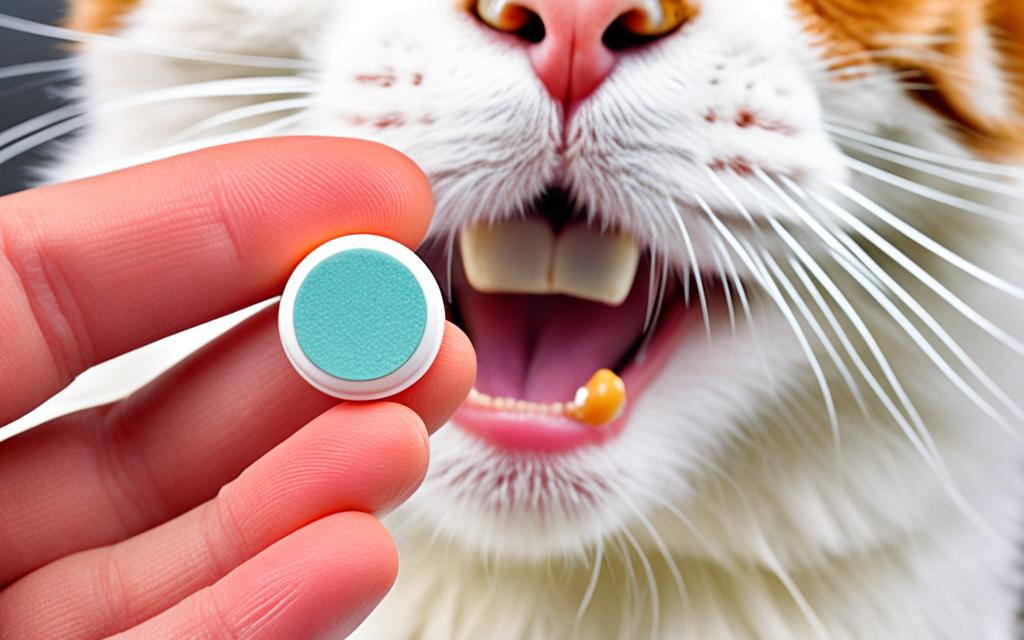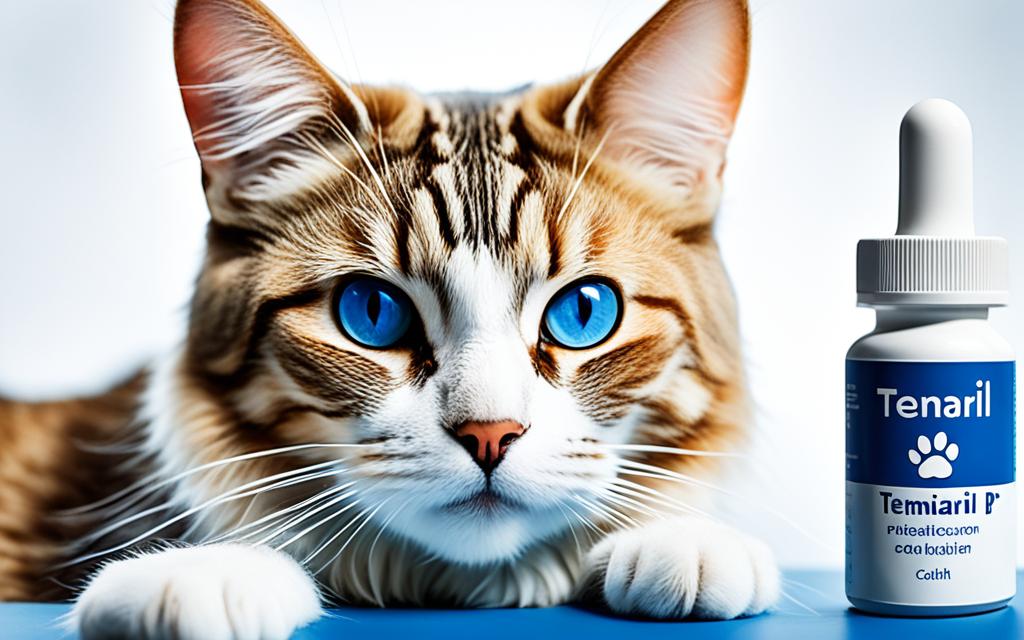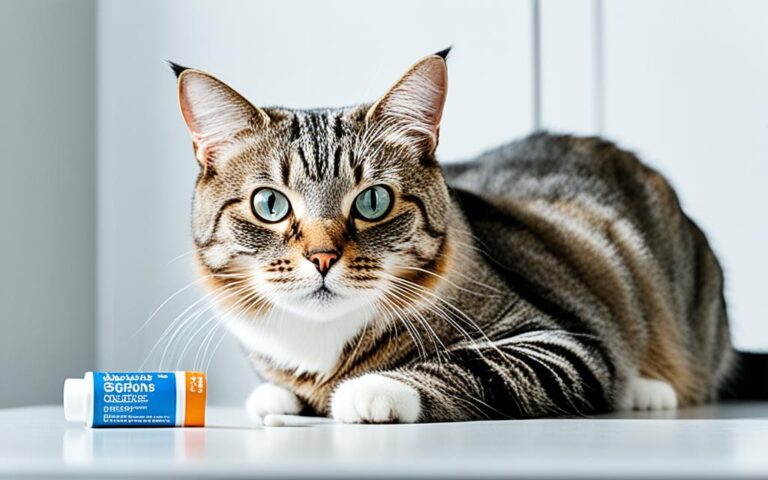Temaril-P for cats: Canine Allergy & Cough Relief
Did you know that Temaril-P helps dogs with itching and coughing? It’s FDA-approved for this. It’s great for environmental allergies and swelling1. This medicine mixes an antihistamine named trimeprazine with a corticosteroid, prednisolone. This mix works well for our dog friends. Interestingly, it’s not common but do find it sometimes used for cats’ itching1.
Key Takeaways
- Temaril-P® is an FDA-approved medication for treating itching and coughing in dogs due to allergies and inflammation.
- Temaril-P® is a combination of the antihistamine trimeprazine and the corticosteroid prednisolone.
- While uncommon, Temaril-P® may be prescribed off-label for treating itching in cats.
- Overdose of Temaril-P® can lead to severe health issues in pets.
- Long-term use of Temaril-P® in dogs is generally avoided due to potential side effects.
Table of Contents
What is Temaril-P®?
Temaril-P® is a drug for dogs approved by the FDA. It’s mainly for itching and coughing due to allergies and inflammation1. This drug has trimeprazine, which is an antihistamine. It also contains prednisolone, a corticosteroid1. While it’s not common to use Temaril-P® for cats, some vets prescribe it for cat itchiness12.
Trimeprazine in Temaril-P® blocks histamine’s effect. Histamine is a chemical that leads to allergy signs like coughs and itches1. Prednisolone fights inflammation through complex steps1. This mix in Temaril-P® helps with itching more effectively than just corticosteroids alone1.
It’s worth noting Temaril-P® is for dogs, but some vets can use it for cats. This use for cats is off-label, decided by the vet for the cat’s needs2. In some cases, a vet might suggest a different form of Temaril-P® if the regular one isn’t the best option for the pet’s health1.
| Key Facts about Temaril-P® | Details |
|---|---|
| FDA Approval | Approved for use in dogs2 |
| Use in Cats | Off-label or extra-label use2 |
| Dosing | Typically prescribed for twice-daily dosing2 |
| Onset of Action | Takes effect quickly, in about 1 to 2 hours2 |
| Cost | $1.18 per tablet3 |
Temaril-P® can help dogs with allergies and inflammation symptoms. Its use for cats is more limited, but it might be an option with vet guidance123.
How Temaril-P® Works
Temaril-P® is a special medicine for pets. It’s used by vets to help with itching and coughing in cats and dogs4.
One part of Temaril-P® is an antihistamine called trimeprazine. It stops histamine, a chemical that causes allergy symptoms. These symptoms can include coughing and itching4.
The other part, prednisolone, is a corticosteroid. It fights body reactions that cause swelling and pain. It does this in a few different ways4.
Both these ingredients work together in Temaril-P®. They fight conditions like allergies and swelling. These problems can make pets feel really bad45.

Temaril-P® is okay for dogs, but not specifically approved for cats by the FDA. Vets can still use it for cats when needed. Always follow your vet’s advice6.
This medicine is good for both kinds of pets. It has the right mix of antihistamine and corticosteroid. This mix helps pets feel better when they’re not well46.
Learning about Temaril-P® shows how it can help your pet. Working with your vet is key to making sure it works well and is safe456.
Temaril-P® (trimeprazine with prednisolone) for cats
Temaril-P® is meant for dogs according to the FDA. It can be used in cats, but this is not on the label7. This kind of use is called ‘off label’ or ‘extra label’. Your vet will decide if it’s right for your cat.
Considerations for Temaril-P® in Cats
Vets look at both the good and bad sides when thinking about giving Temaril-P® to cats7. Cats get much smaller doses than dogs. Your cat’s health and past medical problems are big parts of this decision.
Using Temaril-P® in cats is ‘extra label’. This means the FDA didn’t say it’s okay for use in cats7. But sometimes, vets think it’s the best choice for your cat’s sickness.
If your vet suggests Temaril-P® for your cat, listen carefully about how to give it and check your cat’s health. You might need to go back to the vet for tests to make sure the medicine is safe and works well for your cat.
“The use of Temaril-P® in cats is considered ‘extra-label’ or ‘off-label’, meaning it is not specifically approved by the FDA for that purpose. However, veterinarians may still choose to prescribe it if they determine it is the best course of treatment for your cat’s condition.”
Your vet will think about your cat’s special needs when deciding on Temaril-P®. Talking openly with your vet is very important. This helps make sure Temaril-P® is used safely and does good for your cat789.
Administering Temaril-P® to Cats
Temaril-P® is a key medication for cats, mixing trimeprazine and prednisolone. Vets often give it as a tablet8. It is vital to stick to what your vet says about giving this to your cat. This includes the right dose, how often to give it, and any key tips46.
The common dose is ½ to 1 tablet, twice a day, based on your cat’s weight6. Usually, it’s used for only 3 to 5 days at a time. This is to lower the chance of your cat getting side effects6.
Each Temaril-P® tablet has trimeprazine (5 mg) and prednisolone (2 mg). Trimeprazine works to lessen the action of histamines. Prednisolone helps cut down inflammation and slow the immune system in cats6.
You must keep a close eye on your cat with this drug. If you see unusual symptoms like peeing or drinking a lot, being sleepy, swelling, or stomach problems, talk to your vet right away6. Also, if your cat seems to have muscle issues, is very tired, not moving well, seems lost, or has seizures, stop the medication and call your vet immediately6.
Avoid using Temaril-P® in some cases, like if your cat is allergic to either ingredient, has diabetes, or is expecting kittens or nursing6. Tell your vet about all medicines your cat takes. Temaril-P® might not mix well with some drugs, like painkillers or insulin, so the dosages may need adjusting6.

By carefully following what your vet says and watching for any bad signs, using Temaril-P® can be safe and helpful for your cat’s itching or coughing. This way, the risks of side effects are reduced846].
Potential Side Effects and Precautions
Temaril-P® is usually safe for cats, but it can cause side effects10. These may include sleepiness, drinking more water, peeing more, and being hungrier. Cats might also have muscle tremors or feel stiff, be restless, or pant10. Vets need to watch for more hidden effects like changes in blood, extra thirst, and too much peeing10.
If your cat is pregnant, nursing, or has other health issues, be careful about using Temaril-P®10. How bad the side effects are can depend on the dose. Keeping to the right dose can mean fewer or less severe side effects10. When stopping Temaril-P® after long use, it must be done slowly. This is to prevent the body from stopping its own hormone production too suddenly10.
Precautions for Specific Conditions
- Pregnant or lactating cats: Especially with these cats, think twice about using Temaril-P®. It might interfere with baby cat development and the mother’s milk10.
- Medical conditions: If your cat has diabetes, Cushing’s, or a seizure history, be extra careful with Temaril-P®. These cats are at higher risk of bad side effects and need close monitoring by a vet11.
Always talk to your vet about any worries or risks of using Temaril-P® on your cat11. Your vet can recommend the safest dosage and watch for any bad reactions. This makes sure the treatment goes well for your cat11.
Your cat’s health and safety are very important. Knowing about possible side effects and taking steps to prevent them are key. This way, your cat’s experience with Temaril-P® can be good12.
Drug Interactions and Monitoring
Is your cat taking Temaril-P®? Let your vet know what other medications your cat is using8. Temaril-P® might not mix well with some drugs, like amphotericin B and others8. If your cat has been taking Temaril-P® for a while, stopping it should be done slowly to avoid problems8.
Long-term use of Temaril-P® might mean your cat needs regular blood and urine tests8. These tests check your cat’s health and look for any side effects from the medication8. Working closely with your vet and following their advice is key to keeping your cat safe on Temaril-P®13.
| Temaril-P® Interactions | Details |
|---|---|
| Drug Interactions | 685 drugs known to interact with Temaril (trimeprazine)13 92 major, 580 moderate, and 13 minor interactions13 |
| Disease Interactions | 17 disease interactions associated with Temaril13 Conditions include cardiovascular disease, CNS depression, asthma/COPD, and seizure disorders13 |
| Alcohol/Food Interactions | 1 alcohol/food interaction linked to Temaril13 |
Sometimes, vets might give Temaril-P® to cats even though it’s made mainly for dogs. They do this to help with issues like itching and coughing8. In these cases, it’s vital to watch your cat closely. Make sure to keep up with follow-up vet visits to guarantee your cat’s health and happiness.
Being open with your vet and following their advice are vital when your cat is on Temaril-P®13. Staying informed about possible drug interactions and side effects is also important. This knowledge will help ensure your cat gets the best care possible with this medication8.
Comparison with Similar Drugs
Temaril-P® mixes an antihistamine (trimeprazine) with a corticosteroid (prednisolone). This combo might work better for itchiness than just using a steroid alone14. Your vet will know if Temaril-P® is better than other drugs for your cat’s specific issue.
Cetirizine (Zyrtec) and diphenhydramine (Benadryl) help with hives, insect bites, and allergies, but not as much for atopic dermatitis14. Temaril-P®, on the other hand, is great for atopic dermatitis and coughing. Still, it needs to be used carefully in some cases14.
In some cases, your veterinarian might suggest using drugs like oclacitinib (Apoquel) or lokivetmab (Cytopoint) for atopic dermatitis and flea allergies14. But, these also have different side effects. Your vet will talk to you about them14.
The best medicine for your cat depends on what they need and your vet’s advice. They can explain the good and bad of Temaril-P® and other options14.
| Medication | Indication | Potential Side Effects |
|---|---|---|
| Temaril-P® (trimeprazine and prednisolone) | Atopic dermatitis, coughing | Increased thirst, urination, appetite, muscle tremors, restlessness, panting |
| Cetirizine (Zyrtec) | Hives, insect bite hypersensitivity, allergic rhinitis, bronchitis | Drowsiness, dry mouth, dizziness |
| Diphenhydramine (Benadryl) | Hives, insect bite hypersensitivity, atopic dermatitis, motion sickness, sedation | Drowsiness, dry mouth, dizziness |
| Oclacitinib (Apoquel) | Atopic dermatitis, flea allergy dermatitis | Vomiting, diarrhea, loss of appetite, increased susceptibility to infections |
| Lokivetmab (Cytopoint) | Atopic dermatitis, flea allergy dermatitis | Vomiting, diarrhea, lethargy, pain at injection site |
| Cyclosporine | Atopic dermatitis, immune-mediated diseases | Vomiting, diarrhea, loss of appetite |
Always talk to your vet about what’s best for your cat. They’ll make a plan just for them, considering their health and how they react to different meds141516.
Storage and Emergency Procedures
It’s very important to store Temaril-P® right and act quickly if your cat shows any bad signs. This way, you make sure the medicine helps your cat without causing harm.
Storage Requirements
Keep Temaril-P® at room temperature away from light and moisture17. Always store it where kids and pets can’t get to it. This helps avoid accidental swallowing.
Recognizing and Responding to Adverse Reactions
Noticing and dealing with any bad reactions fast is crucial. If your cat might have had too much or starts to feel bad, call the vet right away18.
Signs to watch out for are weakness, feeling dizzy, headaches, and stomach problems18. If they’ve had too much, they might be very tired, act differently, have trouble breathing, or problems with their heart18. Don’t wait – go to the vet as soon as possible for the right care.
Work closely with your vet and always follow their advice on using Temaril-P® for your cat191718.
Conclusion
Temaril-P® helps cats with itchy skin and coughs from allergies and swelling20. Even though it is made for dogs, vets sometimes give it to cats. It uses two medicines, trimeprazine and prednisolone, to fight against these health issues20.
It’s important to always listen to your vet when using Temaril-P® for your cat. Follow the right dose and how often to give it. There are also other things like creams or extra vitamins for the cat’s skin and breathing21.
Learning about Temaril-P® helps cat owners and vets work together. This can make the cat’s life better by dealing with the symptoms. And with a good plan, cats with allergies or breathing problems can get better and stay that way.
FAQ
What is Temaril-P®?
How does Temaril-P® work?
Can Temaril-P® be used in cats?
How is Temaril-P® administered to cats?
What are the potential side effects of Temaril-P® in cats?
Are there any drug interactions or monitoring required with Temaril-P®?
How is Temaril-P® different from other medications for cat allergies and cough?
How should Temaril-P® be stored and what should I do in an emergency?
Source Links
- Temaril-P® (trimeprazine with prednisolone) for Dogs and Cats
- Trimeprazine Tartrate with Prednisolone | VCA Animal Hospitals
- Temaril-P (trimeprazine with prednisoLONE)
- Temaril-P®
- Temaril-P for Cats
- Temaril-P Tablets – Heartland Vet Supply
- Temaril-P®
- Temaril-P Tablet (sold per tablet) | 1800PetMeds
- Temaril-P For Dogs: What You Should Know | Dutch
- Drugs for Itchy Animals – WSAVA2007
- Temaril Interactions Checker – Drugs.com
- A Guide to Dog Allergy Medications – Whole Dog Journal
- Oral Dosage Form New Animal Drugs; Change of Sponsor
- Treating the Itch: The Importance of Breaking the Cycle – WSAVA 2014 Congress
- Temaril-P®
- (\\kzdwfilesp003.corp.zoetis.com\MSDGENDocumentStorage\Prd\atn\sdsca\eu_eng\000159_VanectylŽ-P.pdf)
- X:\WERCSTEMP\DEEDSD\wercs.ps
- Just Ask the Expert: When clients decline immunotherapy for atopy







